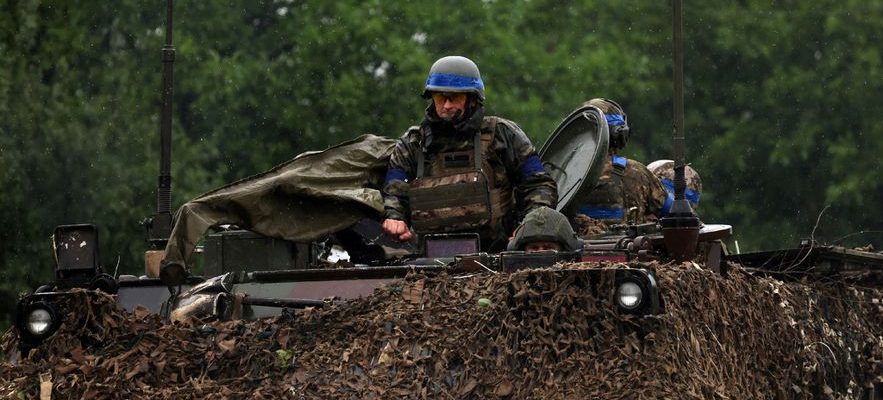The scene takes place on the Zaporizhia front in June. Under the eye of a Russian drone, Ukrainian soldiers attempt to recover comrades injured by mines. Impossible for them to guess where the others are buried, so tall are the grasses. The rescue operation turns into a nightmare: several infantrymen in turn trigger explosions and have their feet or legs torn off on the few meters that separate them from the rear of an American infantry Bradley, charged with the ‘evacuation. Spotted, they then face Russian artillery fire.
Rudimentary but terribly effective, the mines poison the counter-offensive launched at the beginning of June by kyiv. In a few months, Moscow deployed millions of them to reinforce its lines of defense of the occupied territories and to nullify the attempts of reconquest. If the Ukrainians expected it, Russia makes “massive use”, “much more” than what is “planned in its military doctrine”, in order to “slow down Ukrainian attacks in the South”, says the British Ministry of Defense.
“Without Russian mines, a very simple and inexpensive way to hinder the course of a war, the Ukrainians would already be at the borders of their country,” said Marc Chassillan, a former weapons engineer and consultant specializing in armored vehicles. Placed in front of anti-tank ditches and trenches, these minefields prevent manoeuvres. “An exploding mine can ‘untrack’ a tank, destroy an armored vehicle, block a unit and force it to move towards an area within range of fire”, explains a former colonel of engineers.
Ukrainian soldiers in the Zaporizhia region of southern Ukraine on June 11, 2023.
© / afp.com/Anatolii Stepanov
“All these obstacles are generally enhanced by fire, continues this mining specialist. whose shots are often guided by drones. For the assailant, it is either to go into complete reverse or take the risk of being destroyed. This explains why we have seen a lot of vehicles colliding in Ukraine in recent years. weeks.”
Sophisticated dispersion techniques
To lay these mines, the Russians have a whole panoply of machines. The GMZ-3s bury them and cover them with earth. The UMZ-G disperse them by projection up to 40 meters, while a model entering service in 2022, the Zemledeliye, can disseminate them via rockets at 15 kilometers. The Ukrainians also have such remote mining systems with RAAMs, American 155 mm shells capable of dispersing 2.3 kg magnetic mines. These had wreaked havoc at Vouhledar, in March, against a Russian brigade which persisted in pushing its armored vehicles through a trapped crossroads.
The “breaching” of these minefields therefore requires state-of-the-art equipment. Once the targeted area is weakened by intense artillery fire, some engineer vehicles with a large plow will push the mines to the sides or detonate them by rollers, to create a path for offensive units to cross the obstacle line and to attack opposing positions. Other machines can also project a pyrotechnic net in front of them which “cleans” a passage of 10 meters by 100.

© / Art Press
No less than 13 types of anti-tank mines are used in the Ukrainian theater, notes Human Rights Watch (HRW) in a recent report. The most common is the Soviet TM-62, which is the size of a pizza and contains 7.5 kilos of explosive charge. Depending on the model, these mines detonate under pressure or are triggered by a magnetic fuse which detects a mass of metal nearby. Others jump before detonation, with, for some, sensors that allow them to hit an armored vehicle through its roof.
“It’s up to whoever has the most unhealthy ideas”
To these anti-vehicle mines are added anti-personnel mines. Non-signatory of the 1997 Ottawa Convention on the prohibition of their use – as well as the United States and China -, Russia has used “at least 13 types since February 2022” specifies HRW, as well to trap the areas taken over by the Ukrainians – corpses and animals, in some cases – and to reinforce the lines of defense. “The most recent, like the POM-3, operate by seismic sensors, leap and target the least protected parts of the human body of the combatants such as the eyes, the jugular or the groin”, specifies Baptiste Chapuis, of Handicap international, of back from a recent mission to Ukraine.
These anti-personnel mines also complement the other devices deployed in the line of defence. “They aim in particular to kill the deminers sent to an anti-tank minefield or the infantrymen who accompany the armored vehicles behind the demining machine”, points out Marc Chassillan. “Mine warfare is quite vicious, it’s up to whoever has the most unhealthy ideas, sometimes with mines hidden under a mine”, explains the former colonel of engineers.
After the fighting, these mines can also cause humanitarian disasters, such as those dispersed by the flood caused by the destruction of the Nova Kakhovka dam. “They do not distinguish between soldiers and civilians or between a car and a tank, points out Baptiste Chapuis. They are a broader reflection of the problem posed by unexploded ordnance: it will take decades to demine the entire territory, from as much as each type of ammunition is going to require different demining engineering.” A colossal task which cannot begin until the end of hostilities.
